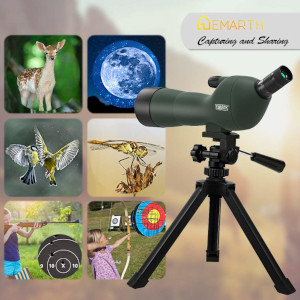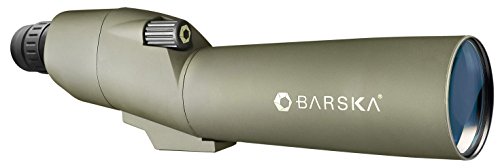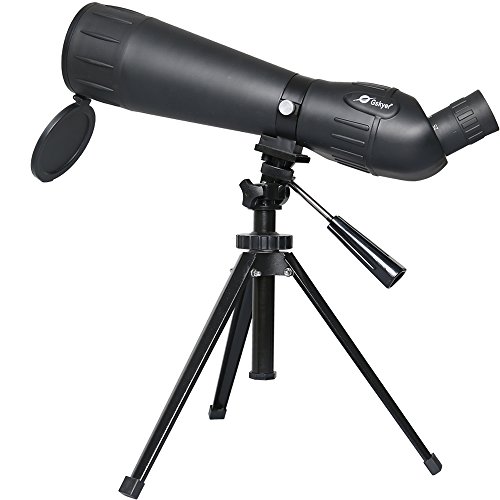5 Best Spotting Scopes Under $100 in 2025 – Reviews & Guide
Last Updated on

You may think that you need to spend hundreds or thousands of dollars to get a quality spotting scope. However, that simply isn’t the case.
These days you can get a spotting scope that does everything for which you’re looking. You can find lightweight spotting scopes, crystal-clear optics, and great magnification for less than $100. However, at this price point, you know that there’s going to be plenty of clunkers mixed in with the real gems. When you’re shopping online, it’s not always going to be clear which models are which.
That’s why we’ve created this list of reviews of some of the best spotting scopes under $100 this year, all of which you could purchase for less than 100 dollars. We’ve also created a buyer’s guide, so if this is your first foray into the world of spotting scopes, you can learn what you should look for when you go to buy.

A Quick Glance at the Winners (2025 Update)
| Image | Product | Details | ||
|---|---|---|---|---|
| Best Overall |
 |
BARSKA Colorado |
|
CHECK PRICE |
 |
Emarth Spotting Scope |
|
CHECK PRICE | |
| Best Value |
 |
Celestron Landscout |
|
CHECK PRICE |
 |
BARSKA CO11502 |
|
CHECK PRICE | |
 |
Gskyer |
|
CHECK PRICE |
The 5 Best Spotting Scopes under $100
1. BARSKA Colorado Spotting Scope – Best Overall
The BARSKA Colorado CO11216 is a great spotting scope, and it easily takes the first place on our list. It comes with a great 60-millimeter lens that does a good job creating images of objects up to 1000 meters away, which can be a challenge for scopes at higher price points. It also comes with a good variable zoom range, offering crisp images from 20 to 60 times magnification. It’s also waterproof, which means it’s safe to take this model out into the field.
For the same low price, you’re also getting a decent tripod and quality carrying case, which adds a lot to the ease of use on this model. The one downside is that it has subpar eye relief. That means that you have to put your eye very close to the eyepiece to see the image. That can be a pain if you wear glasses, as you’ll probably have to take them off to see inside. However, the rest of the features make for a great spotting scope that should provide a long, low-frustration life.
- Good lens
- Good variable zoom
- Waterproof
- Included tripod and case
- Subpar eye relief
2. Emarth 20-60x60AE Spotting Scope
The Emarth 20-60x60AE is our runner-up. It comes with a great 60-millimeter lens that does good work for close and medium-distance viewing. It comes with a variable zoom from 20 to 60 times magnification, and the included tripod means you can be ready to go when you open the box. It also comes with fully multi-coated optics, which means the lens and the internal mirrors are all coated to prevent loss of light and quality, giving you a high-quality final image.
The downside to this model that ultimately keeps it out of first place is that it comes with poor eye relief. Like the last model, if you wear glasses, you’re going to have to take them off to see the image. It also has some minor problems with color aberration that become especially apparent at longer distances and with greater zooms. Overall, this model is great for people who want a cheap but easy-to-setup spotter scope, don’t use glasses, and don’t mind a bit of color aberration.
- Great lens
- Variable zoom
- Fully multi-coated optics
- Poor eye relief
- Some color aberration
3. Celestron Landscout Spotting Scope – Best Value
The Celestron 52322 Landscout 12-36×60 is our choice for best for the money. It comes with fully-coated optics which keep the image bright and clear as it travels through the spotting scope and to your eye. It is also a very lightweight model, clocking in at under three pounds, which makes it great for backpacking trips or other situations where every ounce matters. Unlike most models, this one comes with a large focusing wheel, which makes it exceptionally easy to use without having to look away from your target.
12-36 times magnification isn’t that impressive overall, but it remains a good deal for the price point. Likewise, you’re probably not going to be shopping for an aftermarket eyepiece with more zoom at this price point, but you shouldn’t do that if you buy this model, as it comes with a fixed eyepiece that you can’t change out. While this model does have some limitations, it comes with clear optics and a great ease of use at a price that can’t be beaten.
- Fully-coated optics
- Lightweight
- Large focus wheel
- Underwhelming zoom
- Fixed eyepiece
4. BARSKA 20-60×60 Spotting Scope
The BARSKA 20-60×60 CO11502 is at the low end of usability when it comes to spotter scopes. If you’re looking to see shots in a target at about 100 yards, you’re in luck. This scope can spot those well. Anything past 100 yards is going to get iffy with this model. Depending on the conditions, you may be able to make out larger holes at 200 yards. Past 200 yards, you should probably forget about it. This model includes a pan-head tripod that works well, and as a bonus, the pan-head should be compatible with most tripods, so you can likely use your own if you already own one.
Unfortunately, this model is a straight spotting scope, which means that you lose out on some of the features of an angled model, including an adjustable eyepiece and better images when at a different height than your target. Overall, you’re just not getting great value out of this scope. You could spend a bit more or a bit less and get a scope that you’ll end up liking a lot more.
- Decent magnification at 100 yards
- Included pan-head tripod
- Price
- Bad past 100 yards
- Straight spotter scope
5. Gskyer 25-75×75 Spotting Scopes
The Gskyer 25-75×75 is a great example of a spotting scope that doesn’t live up to its potential. It has a massive 75-millimeter lens that should, in theory, make good on its 75-times maximum magnification. However, it isn’t built well enough to make good on that promise. Ultimately, it has poor clarity across most of its zoom range, and the image gets progressively darker as you increase the zoom, leading to especially poor image quality at maximum zoom.
It also isn’t designed with eye relief in mind, so if you use glasses, you’re going to have to take them off to use this model. Add to that the fact that this model is difficult to focus and you have a mess of a spotting scope. You’re not going to get a lot of easy, satisfying use out of this model. Instead, it’s going to be one of the more frustrating experiences you have, and since this is one of the more expensive models on this list, you should give it a hard pass and move on to something better.
- Good magnification
- Poor clarity
- Bad eye relief
- Dark images at longest range
- Hard to focus

Buyer’s Guide: Finding the Best Spotting Scope
We hope that our reviews have given you some ideas about what you should look for when shopping for a spotting scope. If you’re still not sure which model is right for you or want more information about spotting scopes, check out this buyer’s guide that is full of good general information about these tools.
Straight vs. angled
While manufacturers often play up the straight spotting scope vs. angled spotting scope as a matter of comfort, there’s more to it than that. While the angled spotting scope is generally more comfortable, since you can reposition the eyepiece to an angle convenient angle, you still need to consider the optical nature of both types.
Straight spotting scopes are best for viewing targets that are at the same level as you are. If you are significantly higher or lower than your target, you’ll start seeing some chromatic aberration and a general loss of quality with a straight model. Angled models do a better job with height differences than straight models.
Zooms and lens sizes
You can figure out what a spotting scope can do by looking at a pair of numbers. Generally, they’ll look something like this: “20×60” or “20-45×60.” The first number tells you what the magnification is. If there’s just one number, then it is a fixed magnification scope. If there are two numbers, separated by a hyphen, then it is a variable-magnification scope, capable of all magnifications between and including the two listed numbers.
The number after the “x” tells you the lens size in millimeters. Bigger is generally better here, as bigger lenses let in more light, which leads to brighter and higher-quality final images.
Lens and mirror coatings
It’s counterintuitive, but lenses and mirrors don’t inherently do a good job of focusing light. Lenses like to distort the different wavelengths of light, which results in chromatic aberration. Manufacturers solve this problem by using ED, or extra-low diffraction lenses, which reduce chromatic aberration by either using a different cut or applying a chemical layer to the lens to create the same effect.
The glass on untreated mirrors can absorb up to 96% of the light they receive, which results in dim final images. Different companies use different chemical treatments to solve this problem, and the best treatments result in mirrors that reflect up to 83.5% of the light they receive, which creates much brighter images.
Our buyer’s guides for different price ranges:
- What’s the best spotting scope under 500 USD?
- Which spotting scope under $200 is the winner of our tests?
- Is it really worth it to pay $1000 for a spotting scope?

Conclusion
The BARSKA Colorado CO11216 is our pick for the best spotting scope under $100, coming with a waterproof design and a great magnification range and lens. The Emarth 20-60x60AE is our runner-up due to its great lens and fully-coated optics. The Celestron 52322 Landscout 12-36×60 provides great value with its lightweight frame and large focus wheel that makes spotting an easy and quick process. The BARSKA 20-60×60 CO11502 is good for target spotting at about 100 yards but falls off quickly past that distance. The Gskyer 25-75×75 has a lot of problems, including dark images and poor overall clarity, that drop it to the bottom of our list.
Hopefully, our reviews and our buyer’s guide have helped you understand what good spotting scopes are like. You should now be able to use this information to find the spotting scope that is just right for you.
About the Author Robert Sparks
Robert’s obsession with all things optical started early in life, when his optician father would bring home prototypes for Robert to play with. Nowadays, Robert is dedicated to helping others find the right optics for their needs. His hobbies include astronomy, astrophysics, and model building. Originally from Newark, NJ, he resides in Santa Fe, New Mexico, where the nighttime skies are filled with glittering stars.
Related Articles:
How to Clean a Refractor Telescope: Step-by-Step Guide
How to Clean a Telescope Eyepiece: Step-by-Step Guide
How to Clean a Rifle Scope: 8 Expert Tips
Monocular vs Telescope: Differences Explained (With Pictures)
What Is a Monocular Used For? 8 Common Functions
How to Clean a Telescope Mirror: 8 Expert Tips
Brightfield vs Phase Contrast Microscopy: The Differences Explained
SkyCamHD Drone Review: Pros, Cons, FAQ, & Verdict








